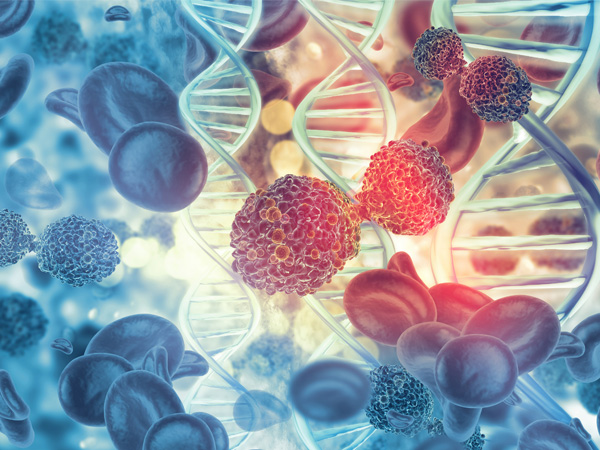- Home
- Science
- Diseases & Conditions
- Prostate Cancer
What Is Prostate Cancer?
Prostate cancer is a type of cancer that forms in the prostate, a gland organ situated before the rectum and under the bladder.1 Part of the reproductive system in individuals assigned male at birth, the prostate produces fluid contained in semen. With prostate cancer, cells in this organ grow uncontrollably and can spread to other parts of the body if left untreated.1
Prostate Cancer Prevalence
In the U.S., prostate cancer is the second-most common cancer in people with prostates (following skin cancer) and the second leading cause of cancer death (following lung cancer).2 According to the American Cancer Society, approximately 1 in 41 people with prostates die of prostate cancer, but most people who are diagnosed with prostate cancer survive. More than 3.1 million people currently living in the U.S. are prostate cancer survivors.2
Roughly 268,490 people in the U.S. will be diagnosed with prostate cancer in 2022, according to estimates from the American Cancer Society, and 34,500 will die from the disease.2 Fortunately, overall prostate cancer survival rates have been improving since 1992, with the current five-year survival rate at 96.8%.3
Causes and Risk Factors

What Causes Prostate Cancer?
Scientists still don't know exactly what causes prostate cancer, but research has identified several genetic mutations and risk factors that may contribute to its development.4
Prostate Cancer and Genetics
Cancers are caused by genetic mutations—DNA changes that turn normal, healthy cells into abnormal, cancerous ones.4 Some genetic mutations can be inherited from the parents at birth, but others are acquired during life.
Genes, which control how cells work, are composed of a chemical called DNA.4 Genes called proto-oncogenes help cells grow, divide to create new cells, and stay alive.5 Genes called tumor suppressor genes regulate cell growth, correct coding errors in DNA, and regulate when cells should die.4,6 Genetic mutations can turn proto-oncogenes into oncogenes. Oncogenes disrupt cell division, causing cells to multiply ceaselessly, which may lead to cancer. DNA mutations can also turn off tumor suppressor genes, which can cause cancer.5,6
Cancer researchers have discovered several inherited gene mutations that are associated with prostate cancer. Some of these mutations occur in tumor suppressor genes, which usually help fix DNA errors in cells or eliminate cells that cannot be fixed. Other mutations are associated with genes that normally repair damaged DNA, or address DNA mismatches that occur when cells divide into two new cells. A rare mutation of a gene that is important for the formation of the prostate gland can also cause early-onset prostate cancer.4
Cancer researchers are investigating other gene mutations that may contribute to prostate cancer, but it is believed that only about 10% of cases are linked to hereditary gene mutations. The rest are caused by mutations acquired during life and are not passed from one generation to the next. Acquired gene mutations may be random events that happen during normal cell division, or they may be linked to certain known prostate cancer risk factors.4
According to the Centers for Disease Control and Prevention, about 13% of Americans with prostates will develop this cancer at some point, and 2% to 3% will die from the disease.7 However, certain demographic, lifestyle, and environmental factors can increase risk, including:
According to the American Cancer Society, about 60% of new prostate cancer diagnoses are in people older than age 65. The disease is rarely found in people with prostates younger than age 40, according to the source, but risk increases rapidly after age 50.8
African American people with prostates are more likely to get prostate cancer and are twice as likely to die from it. They also tend to get prostate cancer at a younger age, be diagnosed at a more advanced stage, and have a more severe type of prostate cancer than people with prostates of other races. Caribbean people of African ancestry with prostates are also at increased risk, while Asian American and Hispanic people with prostates are less likely than non-Hispanic white people with prostates to get prostate cancer.7,8
The risk for hereditary prostate cancer is greater for those who have more than one immediate relative with prostate, breast, ovarian, or pancreatic cancer, or for those who were diagnosed with prostate cancer at age 55 or younger.7
The following factors may have some implications in prostate cancer risk, but are not as clear:8
- Weight
Obesity does not seem to increase the overall risk of getting prostate cancer, but some studies suggest it could increase the odds of being diagnosed with a more aggressive form of the disease.
- Smoking
So far, there is no established link between getting prostate cancer and a history of smoking, but smoking could increase patients’ risk of dying from the disease.
- Exposure to certain chemicals
Some studies suggest that firefighters might be exposed to chemicals that increase the risk of prostate cancer. Agent Orange, a chemical weapon used during the Vietnam War, might also increase the risk.
- Inflammation
Prostatitis (inflammation of the prostate gland) is often found in samples of cancerous prostate tissue. Researchers are trying to determine whether sexually transmitted infections, such as gonorrhea or chlamydia (which can inflame the prostate), might increase cancer risks. So far, there is no concrete evidence of the potential role of inflammation in prostate cancer risk, but its potential role as a risk factor is under investigation.
Prostate Cancer Prevention
Many prostate cancer risk factors cannot be controlled or changed. While the evidence is inconclusive, risk may be lowered by:9
- Maintaining a healthy weight
- Being physically active
- Consuming a healthy diet with a variety of colorful fruits and vegetables and whole grains and limiting red meat, sugary drinks, and foods (including meats) that are highly processed.
Types of Prostate Cancer
A cancer's type depends on where it starts. The vast majority of prostate cancers are adenocarcinomas—cancers that form in gland cells. In the prostate, these cells are responsible for making fluid that is part of semen.10
Rare forms of prostate cancer include:
- Sarcomas (tumors that can occur in tissues near glands)10,11
- Small cell carcinomas10
- Transitional cell carcinomas10
- Neuroendocrine tumors (besides small cell carcinomas)10
Prostate Cancer Symptoms

Different people experience different prostate cancer signs, and some people with prostates experience no symptoms at all before diagnosis. Prostate cancer symptoms may include:12
- Difficulty urinating, especially getting started
- Weak or interrupted urine flow
- Urinating more frequently than usual, especially at night
- Difficulty fully emptying the bladder
- Painful urination or burning sensation
- Blood present in urine or semen
- Prolonged pain in the back, pelvis, or hips
- Pain during ejaculation
Many prostate cancer symptoms could be caused by other health problems, but it's important to see a doctor right away when experiencing signs of prostate cancer or having any concerns.12 As with other cancers, prostate cancer may be more treatable if caught early.13
Diagnosis and Treatment
Prostate Cancer Diagnosis
If prostate cancer symptoms are present or an individual is at high risk, a doctor may perform a prostate cancer screening.13
- Prostate Cancer Screening
Prostate-specific antigen (PSA) testing measures blood levels of PSA. Higher than normal levels of PSA, a substance made by the prostate, can indicate the presence of cancer, among other things.13 The U.S. Preventive Services Task Force (PSTF) currently does not recommend prostate cancer screening for all people with prostates, because it can lead to false-positive results and overdiagnosing.14 In 2018, the PSTF issued new guidelines recommending that people with prostates who are 55 to 69 years old make individual decisions, with guidance from their healthcare providers, about whether to get a PSA test. People with prostates who are aged 70 or older are advised against routine prostate cancer screening.15
If PSA testing suggests that cancer, might be present, a urologist may perform a prostate biopsy. During a biopsy, the urologist will remove a small piece of tissue from the prostate so a pathologist can examine it under a microscope for the presence of cancer cells to help make a prostate cancer diagnosis.16
Prior to the advent of PSA testing, doctors often performed digital rectal exams (DRE) by inserting a lubricated, gloved finger into patients' rectums to feel for anything abnormal, including cancerous growths.13,16 Citing insufficient evidence of benefits, the PSTF now advises against DRE screening.15
- How Prostate Cancer Is Graded
For those with prostate cancer, doctors will use the results of the PSA test, biopsy, and additional imaging tests to determine what type of cancer it is and the stage of its growth.16
First, the cancer tissue will be assigned a grade using the Gleason system, which measures how much the cancer resembles normal prostate tissue. A Gleason grade of 1 means it looks a lot like normal tissue, while a grade of 5 means it looks very abnormal. Because prostate tumors typically have areas with different grades, the pathologist will assign different grades to the two areas that make up most of the cancer, then add those numbers to produce a Gleason score. For example, if most of the tumor is grade 3 and the rest is grade 5, the total Gleason score is 8.16
The Gleason score tells the doctor whether the cancer is:16
- Low-grade: Gleason score of 6 or less
- Intermediate-grade: Gleason score of 7
- High-grade: Gleason scores of 8 to 10
This information is used to help stage the cancer. - Prostate Cancer Stages
After receiving a prostate cancer diagnosis, a healthcare team will need to determine the cancer's stage, or how far it has spread, to decide the best course of treatment. Prostate cancer stages are based on five key pieces of information:17
- The size of the tumor
- Whether it has spread to nearby lymph nodes
- Whether the diagnosis is metastatic prostate cancer, meaning it has spread to other parts of the body
- PSA level at the time of diagnosis
- Gleason score
There are four stages of prostate cancer:17- Stage 1 prostate cancer. The cancer has not reached lymph nodes or other parts of the body. PSA level is less than 10 and Gleason score is 6 or less.
- Stage 2 prostate cancer. Cancer has not spread to lymph nodes or other parts of the body. For subtypes of Stage 2A, Gleason scores are 6 or less. For Stage2 B and Stage 2 C, Gleason scores can be 7 or 8. For all subtypes of Stage 2, PSA scores range between 10-20.
- Stage 3 prostate cancer. In stages 3A, 3B, and 3C, cancer has not spread to lymph nodes or other parts of the body. For 3A and 3B, Gleason scores are 8 or less. For Stage 3C, Gleason scores can be 9 or 10. And PSA levels are at least 20 for Stage 3A, while any PSA score may occur with Stage 3B or C.
- Stage 4 prostate cancer. Stage 4 prostate cancer consists of Stage 4A and Stage 4B. In Stage 4A, the cancer has reached lymph nodes but has not reached other parts of the body. It can have any Gleason score and any PSA level. In Stage 4B, the cancer may or may not have reached nearby lymph nodes, but it has reached other parts of the body. It can also have any Gleason score and any PSA level.
Cancer stages indicate how advanced the cancer is and help doctors decide on treatment options.17
Prostate Cancer Treatment
Once cancer has been diagnosed and staged, the patient and doctors will decide together which prostate cancer treatment is right. A care plan could include the following approaches.
- Expectant Management for Prostate Cancer
If the cancer is low-grade and unlikely to grow quickly, the doctor might recommend postponing treatment for prostate cancer and instead waiting to see if the condition worsens. This might involve active surveillance—close monitoring with regular PSA tests and biopsies—or simply waiting until symptoms develop.18
- Surgery for Prostate Cancer
Prostate cancer surgery may involve a prostatectomy to remove the prostate or a radical prostatectomy to remove the prostate and surrounding tissue. Researchers are currently conducting clinical trials for a new type of surgery called cryotherapy, which uses an instrument to freeze and destroy prostate cancer cells.14,18
- Radiation Treatment for Prostate Cancer
Radiation therapy for prostate cancer uses high-energy rays to eliminate cancer cells, though healthy cells also may be affected by the radiation. There are three types of radiation therapy:18
- External radiation therapy, which uses a machine to direct radiation at cancer cells
- Internal radiation therapy (brachytherapy), where seeds or pellets are surgically placed into or near the cancer to destroy the cells
- Proton beam radiation therapy, an experimental procedure using tiny, high-energy particles with a positive charge to kill tumor cells
- Chemotherapy for Prostate Cancer
Chemotherapy stops the growth of cancer cells either by causing cell death or halting cell division. Chemotherapy may also affect healthy cells. Depending on which drug is used, chemotherapy medications may be administered orally or via injection into muscle tissue or veins.18
- Hormone Therapy for Prostate Cancer
Hormone therapy removes or blocks hormones to stop the growth of cancer cells. It may also affect non-cancerous cells.19 One approach to hormone therapy is called androgen deprivation therapy (ADT). In ADT, doctors use other hormones, drugs, or surgery to reduce the amount of male sex hormones or prevent them from functioning. Hormone therapy for prostate cancer may involve:18
- Antiandrogen drugs, which can prevent androgen production (androgen biosynthesis inhibitors); drugs that can block the action of androgens (antiandrogens); drugs that inhibit the androgen receptor at multiple sites to help slow the growth of cancer cells (androgen receptor inhibitors)18,20
- Orchiectomy surgery to remove one or both testicles and decrease testosterone production18
- Drugs to prevent testicles from making testosterone18
- Targeted Therapy for Prostate Cancer
Targeted therapy for prostate cancer uses drugs or other molecules to preferentially single out and act on cancerous cells. Targeted therapy may also affect healthy cells.18,21
- Immunotherapy for Prostate Cancer
Immunotherapy harnesses the body’s natural defenses—the immune system—to fight cancer. Doctors may administer a cancer vaccine to prompt the immune system to start destroying cancer cells.22
- Bone-targeted therapy
Bone-targeted therapy may treat prostate cancer that has spread to bones, which can lead to broken bones, pain, and other issues. If the patient is on bone-targeted therapy, calcium levels may drop too low and the doctor may recommend vitamin D or calcium. Bone-targeted therapy can help to stop the cancer while also reducing weakness and pain.23
Bone-targeted therapy can also include radiopharmaceuticals, which are radioactive drugs that may reduce bone pain from prostate cancer. They fight cancer by targeting locations where cancer cells are found.23
Global Impact of Prostate Cancer
Prostate cancer is the most frequently diagnosed cancer in people with prostates in most countries worldwide (112 of 185). In people assigned male at birth, prostate cancer was the fifth highest cause of cancer death globally in 2020. According to global prostate cancer statistics, there were 1.4 million new cases diagnosed in 2020 and 375,304 deaths from the disease.24
Mortality rates for prostate cancer have dropped in the majority of high-income countries since the mid-1990s, thanks to better screening through PSA testing. However, during the same time, death rates increased within countries in Asia, Africa, and Central and Eastern Europe, where testing and treatments are limited.24

Frequently Asked Questions About Prostate Cancer
- What is the prostate cancer survival rate?
Prostate cancer that is localized (contained to the prostate) or regional (has only spread to nearby lymph nodes and structures) typically has a five-year survival rate of greater than 99%.25 Distant prostate cancer that has metastasized to parts of the body farther from the prostate (such as the lungs, liver, or bones) has a five-year survival rate of 31%.
- Is prostate cancer curable?
There are many therapies for prostate cancer, including investigational therapies in clinical trials. Treatability depends on the patient's age and overall health and how advanced the cancer is when diagnosed.18
- Can women get prostate cancer?
Anyone with a prostate can get prostate cancer.1
- How common is prostate cancer?
Roughly 13% Americans with prostates will develop prostate cancer during their lifetimes.7
Find Pfizer clinical trials for prostate cancer at PfizerClinicalTrials.com.
Explore prostate cancer clinical trials at ClinicalTrials.gov.
Area of Focus: Oncology
Prostate Cancer is a focus of Pfizer’s Oncology Therapeutic Area. Visit the Oncology Page.
- References
- What is prostate cancer? Centers for Disease Control and Prevention. https://www.cdc.gov/cancer/prostate/basic_info/what-is-prostate-cancer.htm. Last updated August 23, 2021. Accessed February 17, 2022.
- Key statistics for prostate cancer. American Cancer Society. https://www.cancer.org/cancer/prostate-cancer/about/key-statistics.html. Last updated January 12, 2022. Accessed February 17, 2022.
- Cancer stat facts: Prostate cancer. National Cancer Institute. https://seer.cancer.gov/statfacts/html/prost.html. Accessed October 18, 2022.
- What causes prostate cancer? American Cancer Society. https://www.cancer.org/cancer/prostate-cancer/causes-risks-prevention/what-causes.html. Last updated August 1, 2019. Accessed February 17, 2022.
- Oncogene. National Human Genome Research Institute. https://www.genome.gov/genetics-glossary/Oncogene. Updated June 3, 2022. Accessed June 3, 2022.
- Tumor suppressor gene. National Cancer Institute. https://www.cancer.gov/publications/dictionaries/cancer-terms/def/tumor-suppressor-gene. Accessed June 3, 2022.
- Who is at risk for prostate cancer? Centers for Disease Control and Prevention. https://www.cdc.gov/cancer/prostate/basic_info/risk_factors.htm. Last updated August 23, 2021. Accessed February 17, 2022.
- Prostate cancer risk factors. American Cancer Society. https://www.cancer.org/cancer/prostate-cancer/causes-risks-prevention/risk-factors.html. Last updated June 9, 2020. Accessed February 17, 2022.
- Can prostate cancer be prevented? American Cancer Society. https://www.cancer.org/cancer/prostate-cancer/causes-risks-prevention/prevention.html. Last updated June 9, 2020. Accessed February 17, 2022.
- What is prostate cancer? American Cancer Society. https://www.cancer.org/cancer/prostate-cancer/about/what-is-prostate-cancer.html. Updated August 1, 2019. Accessed June 3, 2022.
- Sarcoma. National Cancer Institute. https://www.cancer.gov/publications/dictionaries/cancer-terms/def/sarcoma. Accessed December 14, 2022.
- What are the symptoms of prostate cancer? Centers for Disease Control and Prevention. https://www.cdc.gov/cancer/prostate/basic_info/symptoms.htm. Last updated August 23, 2021. Accessed February 17, 2022.
- What is screening for prostate cancer? Centers for Disease Control and Prevention. https://www.cdc.gov/cancer/prostate/basic_info/screening.htm. Last updated August 23, 2021. Accessed February 17, 2022.
- What are the benefits and harms of screening? Centers for Disease Control and Prevention. https://www.cdc.gov/cancer/prostate/basic_info/benefits-harms.htm. Last updated August 23, 2021. Accessed February 17, 2022.
- Prostate Cancer: Screening. Final Recommendation Statement. US. Preventive Services Task Force. https://www.uspreventiveservicestaskforce.org/uspstf/recommendation/prostate-cancer-screening. Last updated May 8, 2018. Accessed June 3, 2022.
- Tests to stage and diagnose prostate cancer. American Cancer Society. https://www.cancer.org/cancer/prostate-cancer/detection-diagnosis-staging/how-diagnosed.html. Last updated June 10, 2021. Accessed February 17, 2022.
- Prostate cancer stages. American Cancer Society. https://www.cancer.org/cancer/prostate-cancer/detection-diagnosis-staging/staging.html. Last updated October 8, 2021. Accessed February 17, 2022.
- Prostate cancer treatment (PDQ®)–patient version. National Cancer Institute. https://www.cancer.gov/types/prostate/patient/prostate-treatment-pdq#section/_142. Last updated November 12, 2021. Accessed February 17, 2022.
- Hormone therapy for prostate cancer. American Cancer Society. https://www.cancer.org/cancer/prostate-cancer/treating/hormone-therapy.html. Last updated August 9, 20222. Accessed December 14, 2022.
- Rice MA, Malhotra SV, Stoyanova T. Second-generation antiandrogens: from discovery to standard of care in castration resistant prostate cancer. Front Oncol. 2019;9:801.
- Venkatachalam S, McFarland TR, Agarwal N, Swami U. Immune checkpoint inhibitors in prostate cancer. Cancers. 2021;13(9):2187.
- Immunotherapy for prostate cancer. American Cancer Society. https://www.cancer.org/cancer/prostate-cancer/treating/vaccine-treatment.html. Last updated August 1, 2019. Accessed November 4, 2022.
- Treatments for prostate cancer spread to bones. American Cancer Society. https://www.cancer.org/cancer/prostate-cancer/treating/treating-pain.html. Last Updated August 1, 2019. Accessed November 4, 2022.
- Sung H, Ferlay J, Siegel RL, et al. Global cancer statistics 2020: Globocan estimates of incidence and mortality worldwide for 36 cancers in 185 countries. CA: A Cancer Journal for Clinicians. 2021;71(3):209-249. doi:10.3322/caac.21660. Accessed February 17, 2022.
- Survival rates for prostate cancer. American Cancer Society. https://www.cancer.org/cancer/prostate-cancer/detection-diagnosis-staging/survival-rates.html. Last updated February 2, 2021. Accessed February 17, 2022.
The information contained on this page is provided for your general information only. It is not intended as a substitute for seeking medical advice from a healthcare provider. Pfizer is not in the business of providing medical advice and does not engage in the practice of medicine. Pfizer under no circumstances recommends particular treatments for specific individuals and in all cases recommends consulting a physician or healthcare center before pursuing any course of treatment.
Related Articles
Prostate Cancer: Replacing Myths With Facts
Prostate cancer is a major healthcare challenge in the US. It's also the most common cancer in adult men besides skin cancer. But for many men, the words “prostate cancer” stop them in their tracks. This disease is often cloaked in myths, which may lead them to: Avoid screenings. Experience...
Some older people living with cancer aim for remission but lack needed resources to help make treatment decisions, global survey reveals
Every year, World Cancer Day, an initiative led by the Union for International Cancer Control, is about taking action. The theme, “I Am and I Will,” charges us as a cancer community to rally together and better serve those living with the disease and their support systems. At Pfizer, one way we...
Health Screenings Every African American Man Should Know
For many men, cancer is a word you would rather avoid. Yet, learning about cancer may help you keep your health in check. Did you know about 30,000 African American men will be told they have prostate cancer this year?




